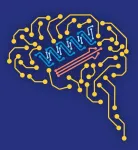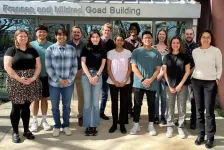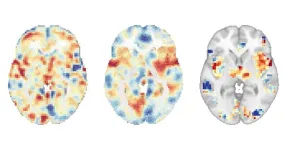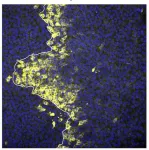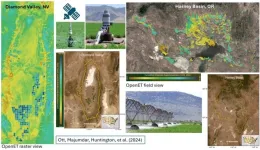(Press-News.org) Researchers at Auburn University, in collaboration with scientists from the University of Basel and ETH Zurich, have made a groundbreaking advance in the fight against cancer. The team, led by Dr. Rafael Bernardi, Associate Professor of Biophysics in the Department of Physics, has developed a novel approach integrating artificial intelligence (AI) with molecular dynamics simulations and network analysis to enhance the prediction of binding sites on the PD-L1 protein. This breakthrough promises to accelerate the development of personalized cancer treatments by identifying critical interaction points in cancer-related proteins.
Their work, published in the prestigious Journal of the American Chemical Society, focuses on understanding how therapeutic proteins interact with PD-L1, a protein known to help cancer cells evade detection by the immune system. Their findings could be instrumental in improving immunotherapies, such as pembrolizumab (Keytruda), that are already revolutionizing cancer treatment.
“Utilizing computational tools to engineer proteins represents the next frontier in cancer therapeutics,” said Dr. Bernardi. “Our integrated approach combining AI, molecular dynamics, and network analysis holds immense potential for developing personalized therapies for cancer patients.”
AI Meets Biophysics: Mapping the Future of Cancer Therapy
One of the greatest challenges in cancer therapeutics is accurately predicting where a drug can bind to its target protein. In this case, the researchers focused on PD-L1, a checkpoint protein that cancers exploit to suppress the immune system. By blocking PD-L1, some modern drugs unleash the immune system to attack tumors. However, understanding where exactly to target PD-L1 with new treatments has been a longstanding problem.
Dr. Bernardi and his team have developed a sophisticated method that combines AlphaFold2-based AI tools with molecular dynamics simulations and dynamic network analysis. Their approach allowed them to predict and confirm key binding regions in the PD-L1 protein that are critical for drug interaction.
“This work showcases the importance of collaboration between the computational team at Auburn University and the experimental validation efforts of our colleagues at the University of Basel and ETH Zurich, Switzerland, driving forward breakthroughs in the field,” said Dr. Diego Gomes, the leading author of the work and a researcher at Auburn.
The computational approach was validated with cutting-edge experimental techniques, including cross-linking mass spectrometry and next-generation sequencing. These experiments confirmed the accuracy of the team’s predictions, demonstrating the power of combining computational models with experimental validation to unravel complex protein-protein interactions.
Impact and Future Directions
The implications of this study go far beyond PD-L1. The methods developed can be applied to many other proteins, potentially leading to the discovery of new drug targets for various diseases, including other types of cancer and autoimmune conditions. Additionally, this research paves the way for more cost-effective and rapid development of therapeutics, an area where traditional experimental methods can be slow and expensive.
“This research stresses the potential of computational tools like NAMD and VMD, combined with cutting-edge hardware such as NVIDIA DGX systems, to advance cancer therapeutics. Our findings mark a significant step toward developing new, targeted treatments for cancer,” added Gomes.
Auburn University’s biophysics team, composed of faculty from the departments of Physics, Chemistry, and Biological Sciences, is committed to pushing the boundaries of science to tackle some of the biggest challenges in medicine today. This study is yet another example of how interdisciplinary collaboration is at the heart of scientific innovation.
About Auburn University
Auburn University is an R1 institution, recognized as one of the top public land-grant universities in the Southeast United States. It offers cutting-edge research opportunities in biophysics, computational biology, and numerous other fields, contributing to groundbreaking innovations in science and technology.
END
AI unlocks new path to personalized cancer treatments
A team led by Auburn University, in collaboration with the University of Basel and ETH Zurich, leverages AI and molecular simulations to uncover new pathways for precision cancer treatments, paving the way for more effective, personalized therapies.
2024-09-05
ELSE PRESS RELEASES FROM THIS DATE:
ResearchGate and Mary Ann Liebert, Inc. announce journal home partnership for open access journals
2024-09-05
ResearchGate, the professional network for researchers, and Mary Ann Liebert, Inc., a global media company dedicated to creating, curating, and delivering impactful peer-reviewed research and authoritative content services, are pleased to announce a new partnership through ResearchGate’s innovative Journal Home offering.
The partnership covers five Mary Ann Liebert, Inc. open access journals spanning the health and medical sciences. All backfile content and all new articles published with ...
Center for BrainHealth investigates the relationship between cannabis use, sleep and memory
2024-09-05
Dallas, September 5, 2024 – The growing legal use of recreational and medical cannabis has generated an increased concern for potential side effects from long-term use, particularly regarding problems with memory and sleep. Until now, the effect of cannabis use on sleep and on memory have only been studied separately. Research led by Francesca Filbey, PhD, from the Laboratory of Neuroimaging of Reward Dynamics at The University of Texas at Dallas’ Center for BrainHealth®, in collaboration with a team from the University of Amsterdam, aimed to fill this gap by testing how sleep impacts memory among cannabis users.
The study, “The ...
K-State researchers determine molecular interactions in plants
2024-09-05
Plant scientists have long known that phosphorus is a crucial component in plant growth. A major discovery by a K-State biologist and her lab is leading to a better understanding of how plants detect and use that resource — potentially leading to more efficient production of crops for food, fiber and fuel.
A team of researchers led by Kathrin Schrick, associate professor of biology, recently published this research in New Phytologist, a high-impact journal in the plant sciences.
Schrick's lab focused on a specific transcription factor that regulates gene expression during development. They discovered a new kind of molecular interaction between the ...
Study estimates home blood pressure devices don’t fit properly for more than 17 million US adults
2024-09-05
Over-the-counter blood pressure measuring devices offer a simple, affordable way for people to track hypertension at home, but the standard arm-size ranges for these devices won’t appropriately fit millions of U.S. consumers, according to a new study from researchers at the Johns Hopkins Bloomberg School of Public Health.
The researchers compared standard arm cuff size ranges for popular retail automatic blood pressure measuring devices to arm circumference data from U.S. government-sponsored national ...
Brain scans reveal that mindfulness meditation for pain is not a placebo
2024-09-05
Pain is a complex, multifaceted experience shaped by various factors beyond physical sensation, such as a person’s mindset and their expectations of pain. The placebo effect, the tendency for a person’s symptoms to improve in response to inactive treatment, is a well-known example of how expectations can significantly alter a person’s experience. Mindfulness meditation, which has been used for pain management in various cultures for centuries, has long been thought to work by activating the placebo response. However, scientists have now ...
Cancer research in space for life on earth
2024-09-05
WINSTON-SALEM, N.C. – September 5, 2024 — The Wake Forest Institute for Regenerative Medicine (WFIRM) is honored to announce its selection for a pioneering cancer research project that will take place aboard the International Space Station (ISS). The project, one of only five chosen through a competitive solicitation by the ISS National Lab in partnership with NASA, aims to explore the effects of microgravity on cancer development and treatment.
The project, led by Dr. Shay Soker, focuses on the use of organoids—miniature, simplified versions of organs grown in the lab from cells recovered from colorectal cancer patients. ...
Research spotlight: Radiology test can be used to diagnose immune checkpoint inhibitor-associated acute kidney injury
2024-09-05
How would you summarize your study for a lay audience?
Immune checkpoint inhibitors (ICIs) are a class of immunotherapy that have revolutionized the treatment of cancer. However, they can cause a wide variety of autoimmune toxicities, including immune checkpoint inhibitor-associated acute kidney injury (ICI-AKI). Differentiating ICI-AKI from acute kidney injury (AKI) due to alternative causes, which are common in cancer patients, is challenging without a kidney biopsy due to the risk of bleeding for some patients.
In this study, we ...
Rice’s Aryeh Warmflash awarded $1.6M NIH grant for research on early human development
2024-09-05
Researchers at Rice University are working to understand how a single cell evolves into the complex network of specialized cells that form the human body. Funded by a $1.6 million grant from the National Institutes of Health, the research team’s new study could advance our knowledge of developmental disorders and contribute to the future of regenerative medicine.
Led byAryeh Warmflash, an associate professor of biosciences and Cancer Prevention and Research Institute of Texas Scholar in cancer ...
Researchers make mouse skin transparent using a common food dye
2024-09-05
Seeing what’s going on inside a body is never easy. While technologies like CT scans, X-rays, MRIs, and microscopy can provide insights, the images are rarely completely clear and can come with side effects like radiation exposure.
But what if you could apply a substance on the skin, much like a moisturizing cream, and make it transparent, without harming the tissue?
That’s what Stanford scientists have done using an FDA-approved dye that is commonly found in food, among several other light-absorbing molecules that exhibit similar effects. Published in Science on ...
Groundwater use can be accurately monitored with satellites using OPENet, new study finds
2024-09-05
Drought is a widespread concern in the Western U.S., and water managers across the region are developing groundwater management plans to conserve the essential resource. Groundwater is often pumped to the surface to irrigate crops, and meters that measure the flow of pumped water have historically offered the best information on groundwater use. These meters are rare, however, so DRI scientists set out to determine whether OpenET, a platform that measures evapotranspiration using satellite data, could help fill this information gap.
The new study, published August 8th in a special issue of Agricultural Water Management, compared groundwater meter ...
LAST 30 PRESS RELEASES:
Air pollution exposure and birth weight
Obstructive sleep apnea risk and mental health conditions among older adults
How talking slows eye movements behind the wheel
The Ceramic Society of Japan’s Oxoate Ceramics Research Association launches new international book project
Heart-brain connection: international study reveals the role of the vagus nerve in keeping the heart young
Researchers identify Rb1 as a predictive biomarker for a new therapeutic strategy in some breast cancers
Survey reveals ethical gaps slowing AI adoption in pediatric surgery
Stimulant ADHD medications work differently than thought
AI overestimates how smart people are, according to HSE economists
HSE researchers create genome-wide map of quadruplexes
Scientists boost cell "powerhouses" to burn more calories
Automatic label checking: The missing step in making reliable medical AI
Low daily alcohol intake linked to 50% heightened mouth cancer risk in India
American Meteorological Society announces Rick Spinrad as 2026 President-Elect
Biomass-based carbon capture spotlighted in newly released global climate webinar recording
Illuminating invisible nano pollutants: advanced bioimaging tracks the full journey of emerging nanoscale contaminants in living systems
How does age affect recovery from spinal cord injury?
Novel AI tool offers prognosis for patients with head and neck cancer
Fathers’ microplastic exposure tied to their children’s metabolic problems
Research validates laboratory model for studying high-grade serous ovarian cancer
SIR 2026 delivers transformative breakthroughs in minimally invasive medicine to improve patient care
Stem Cell Reports most downloaded papers of 2025 highlight the breadth and impact of stem cell research
Oxford-led study estimates NHS spends around 3% of its primary and secondary care budget on the health impacts of heat and cold in England
A researcher’s long quest leads to a smart composite breakthrough
Urban wild bees act as “microbial sensors” of city health.
New study finds where you live affects recovery after a hip fracture
Forecasting the impact of fully automated vehicle adoption on US road traffic injuries
Alcohol-related hospitalizations from 2016 to 2022
Semaglutide and hospitalizations in patients with obesity and established cardiovascular disease
Researchers ‘listen in’ to embryo-mother interactions during implantation using a culture system replicating the womb lining
[Press-News.org] AI unlocks new path to personalized cancer treatmentsA team led by Auburn University, in collaboration with the University of Basel and ETH Zurich, leverages AI and molecular simulations to uncover new pathways for precision cancer treatments, paving the way for more effective, personalized therapies.
